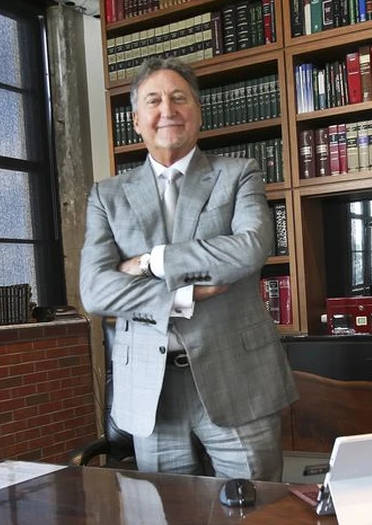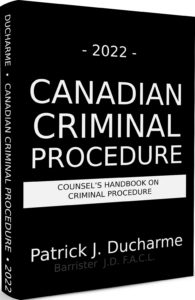 |
| Patrick Ducharme |
How does a preliminary inquiry Judge determine credible or trustworthy evidence when the evidence is only written statements? Who bears the onus of establishing the evidence submitted by way of statements is credible or trustworthy? Credible or trustworthy is a necessary condition for the admissibility of evidence under subsection 540 (7). It requires that the presiding Justice “considers” the proposed evidence credible or trustworthy “in the circumstances of the case.” The last phrase suggests that 540 (7) applications must be considered on a case-by-case basis.
In R. v. Muzhikov1 Wright J. was the presiding Justice at a preliminary dealing with multiple accused charged with several offences that essentially alleged forcible confinement of named persons for the purpose of introducing them to prostitution, or, performing the services of a prostitute. Each of the named persons, alleged to be victims of forcible confinement, had gone missing immediately prior to the commencement of the preliminary inquiry. Consequently, the Crown pursuant to these provisions, sought to file the statements of the two witnesses instead of calling viva voce evidence.
Wright J. found that the words “credible or trustworthy” are used in the same context as they are used in section 518 of the Criminal Code. Credible or trustworthy evidence requires “a prima facie air of reliabilty” to allow a court to consider it as evidence.2 It need not be sufficient to base a conviction, but it must be suitable for consideration as to whether there is some evidence for a jury to properly consider at trial.
In R. v. Francis4 Ratushny J. received applications by two accused seeking certiorari on committals to trial on the basis that the preliminary inquiry Justice exceeded his jurisdiction:
a. When he breached the principles of natural Justice by refusing to permit the applicants, pursuant to subsection 540 (9) to cross-examine the witness and make submissions on the threshold admissibility of that witness’s evidence regarding the “credibility or trustworthy” requirements of section 540 (7), before the evidence was admitted under that section;
b. When he failed to follow the mandatory procedures under subsections 540 (8) and (9) requiring reasonable notice of the intention to introduce evidence under subsection 540 (7) and examination or cross-examination of the witness before admitting that evidence;
c. By his ruling that there was sufficient evidence of identification to meet the Sheppard (sic) test of some evidence of this essential element upon which a reasonable jury properly instructed could convict and based his decision on evidence improperly admitted under subsection 540 (7).
This case demonstrates that credible or trustworthy evidence under subsection (7) may have a different meaning at a preliminary inquiry than what that phrase would mean at trial. Determining what is credible or trustworthy evidence does not require the Justice presiding at the preliminary to weigh the evidence. All that is required at a preliminary inquiry to determine that the evidence is credible or trustworthy is that that evidence have a prima fascia air of reliability. And, when determining if evidence is credible or trustworthy, each Justice confronted with this task of interpreting its admissibility must do so on a case-by-case basis.
This case was heard by Her Honour approximately one year after these amendments became law. The Crown had sought to introduce a video statement on the first day of the preliminary inquiry. The Crown also sought to introduce a transcript of the witness’s testimony from an earlier court proceeding that did not involve the applicants. The Crown had not given any advance notice of the witness’s testimony from the earlier court proceeding. The Crown was seeking admission of the video statement to demonstrate that it was “credible or trustworthy”.
Although the presiding Justice initially determined that the Crown had not provided adequate notice for the court statement, his ruling changed on the second day of the preliminary. On the second day he ruled that the issue of inadequate notice had become moot by virtue of the passage of time since the first day of the preliminary inquiry. Now, both items of evidence were admissible.
He stated it was the Crown that must meet the burden of demonstrating that the evidence it wished admitted under these subsections was “credible or trustworthy”. He ruled, however, that the question of burden of proof related only to threshold admissibility and not to the ultimate issue of credibility or trustworthiness, questions, he said, that must be left to the jury.
Ratushny J. agreed with Wright J. in Muzhikov that the information sought to be introduced under subsection (7) has to, at least, have a prima facie air of reliabilty to allow it to be admitted on the preliminary inquiry.5 She also found that the evidentiary threshold applied to the admission of hearsay evidence at trial should not be applied to evidence contemplated to be admitted pursuant to subsection (7). She found that the subsection itself implies a lesser threshold of admissibility by allowing the receipt of evidence described as “any information that would not otherwise be admissible.”
The consideration of whether the tendered information is “credible or trustworthy” remains only a threshold question of admissibility in the context of the screening function of a preliminary inquiry.7 These issues, at least in part, were also before the Court of Appeal for Québec in R. v. P.M.8 The Crown in P.M. had maintained that the Justice committed an error in stating the burden of proof. According to the Crown, the accused had to justify his application for cross-examination by “preponderant” evidence and had not done so.
The Crown also argued that, through the combined effect of subsections (7) and (9), cross-examination had become the exception when the prosecution intends to prove its case by means of a credible or trustworthy statement. The appellate court disagreed.10 The court found that the credible or trustworthy character of the statements is a necessary condition for their reception in evidence. It found that this aspect is to be assessed by the Justice at “a first stage.”
The relevance of the evidence is assessed next. The court found that a statement deemed trustworthy does not thereby become more relevant. The court suggested that the Crown’s interpretation could have “disastrous consequences” for the preliminary inquiry. In doing so, the court quoted Professor Paciocco (now Paciocco J.) with approval when he wrote:
Depending on how it is interpreted, and depending on how it integrates into the existing legislation, an amendment that will permit the reception of inadmissible hearsay evidence could go beyond simply putting the preliminary inquiry into intensive care; it could prove fatal to the preliminary inquiry in most cases, even without further statutory intervention.
The court also quoted Professor Paciocco (now Paciocco J.) with approval when he wrote:
In other words, while there is no constitutional right to have a pretrial determination of the sufficiency of the case, if the denial of the preliminary inquiry results in an inadequate disclosure there is a Charter violation. The discovery function of the preliminary inquiry is therefore hardly secondary or ancillary according to the constitutional jurisprudence; it is the sole function to acquire constitutional support.
Cross-examination can turn lines of disclosure into pages of discovery, enabling defence counsel to explore information not found in what are often the selective, even skeletal statements obtained by the police. It permits the defence to correct innocent non-disclosure caused by prosecutors or police officers who failed to see the relevance of information that the accused uncovers during cross examination, and it permits defence counsel to observe the demeanor and quality of the witnesses, factors important in the tactical decisions that counsel will make…
And, the court agreed with Ratushny J. in R. v. Francis offering this opinion:
In R. v. Sonier (citation omitted) Omatsu J. observed that in bringing in these new amendments, Parliament did not intend to eliminate the secondary discovery function of the preliminary inquiries or to convert preliminary inquiries into a paper hearing. I agree and see no reason to believe otherwise, partly in light of the screening device and discovery mechanism purposes of the preliminary inquiry as described by Hynes, supra, that appear alive and well at this time and are reflected in the retention of Part XVIII of the Criminal Code dealing with the preliminary inquiry and in section 541, retaining the right of the accused to call its own witnesses.
Sadly, the court did not offer specific answers to the questions of who bears the burden of demonstrating credible or trustworthy and upon what basis. By commenting that the Crown’s suggestion that the burden rests with the accused could have disastrous consequences, one assumes that the court, without expressly stating, believes the burden falls to the Crown. The court did refer to the Parliamentary Research Branch that wrote the following in a legislative summary prepared prior to the passage of this legislation:
Clause 29 permits a preliminary inquiry Judge to receive otherwise inadmissible evidence which the Judge considers to be credible or trustworthy, including a recorded statement of the witness, provided that the party offering the evidence gave reasonable notice to the other parties or the Judge ordered otherwise. In such a case, however, a party is able to apply to the Judge to have the source of such evidence appear for examination or cross-examination.
The court concluded that the intention of Parliament does not support the Crown’s theory that cross examination on a statement produced via 540 (7) was to be considered an exceptional circumstance.
Although the primary purpose of the inquiry is to determine if there is sufficient evidence to order the accused to trial,17 the preliminary inquiry also serves to protect the accused from a needless and improper exposure to a public trial and is also a forum where the accused is afforded an opportunity to discover and to appreciate the case to be made against him at trial.

The above is the an excerpt of Patrick J Ducharme's book, Canadian Criminal Procedure, available at Amazon or in bulk through MedicaLegal Publishing along with Criminal Trial Strategies.
Subscribe to Patrick Ducharme's Youtube Channel
